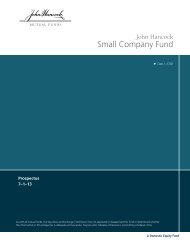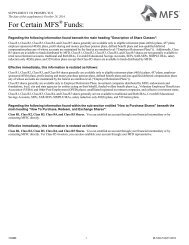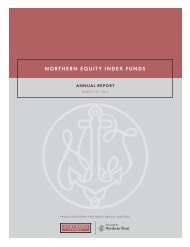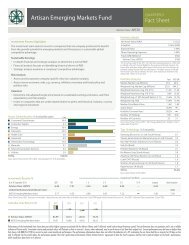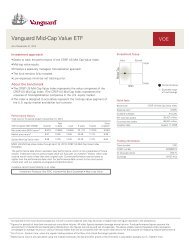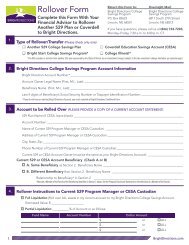Dodge & Cox Funds Statutoary Prospectus dated May 1, 2013
Dodge & Cox Funds Statutoary Prospectus dated May 1, 2013
Dodge & Cox Funds Statutoary Prospectus dated May 1, 2013
Create successful ePaper yourself
Turn your PDF publications into a flip-book with our unique Google optimized e-Paper software.
condition. The Fund could lose money if the issuer orguarantor of a debt security, or the counterparty to aderivative instrument or other transaction is unable orunwilling to make timely principal and/or interestpayments, or to otherwise honor its obligations. If anissuer defaults, or if the credit quality of an investmentdeteriorates or is perceived to deteriorate, the value ofthe investment could decline.▪ Below investment grade securities risk. Debt securitiesrated below investment grade, also known as “highyield”or “junk” securities, have speculativecharacteristics. These securities may yield a higher levelof current income than higher-rated securities, butgenerally have greater credit risk, more price volatility,and less liquidity.▪ Call risk. During periods of falling interest rates, issuersof callable bonds may repay securities with higherinterest rates before maturity. This could cause theFund to lose potential price appreciation and reinvestthe proceeds at lower interest rates.▪ Derivatives risk. The Fund’s use of interest rate andcredit derivatives involves risks different from, andpossibly greater than, the risks associated with investingdirectly in securities and other more traditionalinvestments. These derivatives are subject to potentialchanges in value in response to interest rate changes, orother market developments, or the risk that a derivativetransaction may not have the effect <strong>Dodge</strong> & <strong>Cox</strong>anticipated. Credit default swaps are subject to creditrisk relating to the issuer or issuers of the referenceobligations. Derivatives also involve the risk ofmispricing or improper valuation and poor correlationbetween changes in the value of a derivative and theunderlying asset. Derivative transactions may be highlyvolatile, and can create investment leverage, whichcould cause the Fund to lose more than the amount ofassets initially contributed to the transaction, if any.There is also the risk that the Fund may be unable toclose out a derivative position at an advantageous timeor price, or that a counterparty may be unable orunwilling to honor its contractual obligations,especially during times of financial market distress.▪ Liquidity risk. The Fund may not be able to purchase orsell a security in a timely manner or at desired prices orachieve its desired weighting in a security.▪ Mortgage and asset-backed securities risk. Early repaymentof principal (e.g., prepayment of principal due to sale ofthe underlying property, refinancing, or foreclosure) ofmortgage-related securities (or other callable securities)exposes the Fund to a potential loss on any premium toface value paid and to a lower rate of return uponreinvestment of principal. During periods of risinginterest rates, prepayment rates may decline below whatwas anticipated, delaying the return of principal to theFund and affecting its ability to reinvest at higheryields. In addition, changes in the rate of prepaymentalso affect the price and price volatility of a mortgagerelatedsecurity. Securities issued by certain U.S.government sponsored enterprises (GSEs) (such asFannie Mae, Freddie Mac, the Federal Home LoanBanks, and the Federal Farm Credit Banks) are notissued or guaranteed by the U.S. Treasury. In the eventthat these GSEs cannot meet their obligations, therecan be no assurance that the U.S. government willcontinue to provide support, and the Fund’sperformance could be adversely impacted.▪ Sovereign debt risk. Sovereign debt includes investmentsin securities issued or guaranteed by a foreign sovereigngovernment or its agencies, authorities, or politicalsubdivisions. An investment in sovereign debtobligations can involve a high degree of risk, includingspecial risks not present in corporate debt obligations.The issuer of the sovereign debt or the governmentalauthorities that control the repayment of the debt maybe unable or unwilling to repay principal or interestwhen due. Holders of sovereign debt may be requestedto participate in the rescheduling of such debt and toextend further loans to governmental entities. In theevent of a default by a governmental entity on asovereign debt obligation, there may be few or noeffective legal remedies for collecting on such debt.▪ Leveraging risk. Certain Fund transactions, such asderivatives, may give rise to a form of leverage and mayexpose the Fund to greater risk of loss. Leverage tendsto magnify the effect of any decrease or increase in thevalue of the Fund’s portfolio securities, and thereforemay cause the Fund’s performance to be more volatile.The use of leverage may cause the Fund to liquidateportfolio positions when it would not be advantageousto do so in order to satisfy its obligations.PAGE 14 ▪ D ODGE & C OX F UNDS




